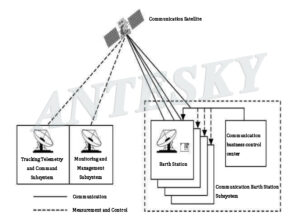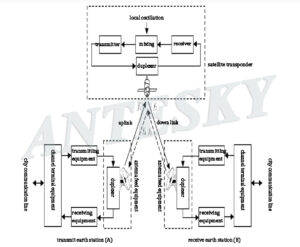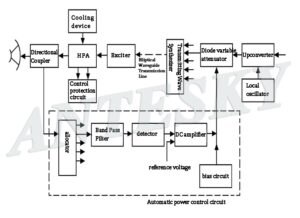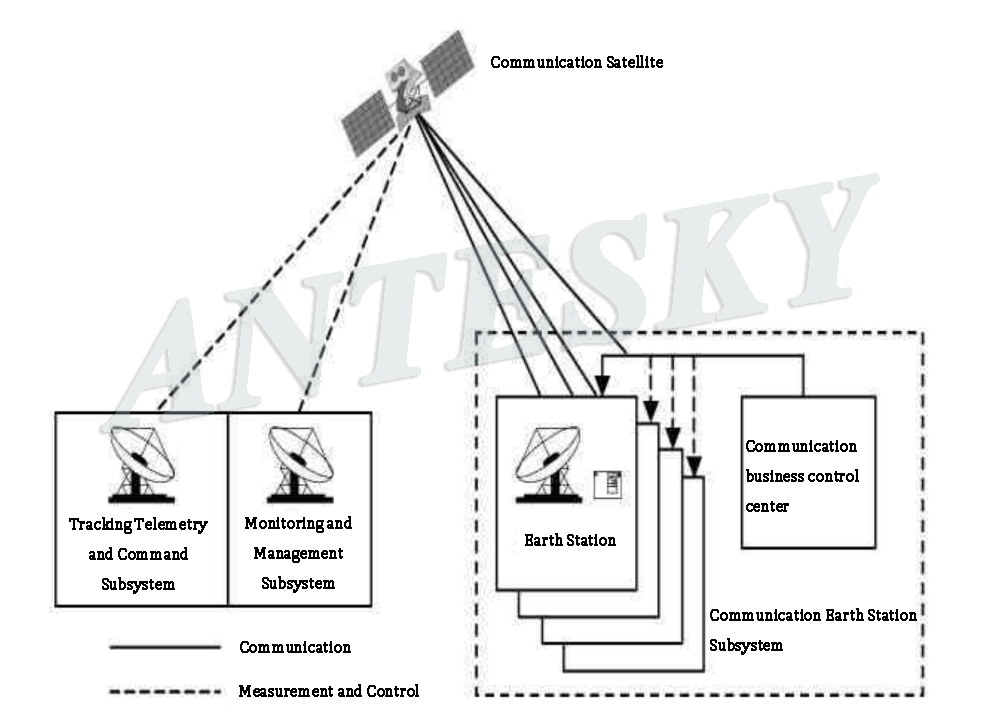
A satellite communication system is composed of four major parts: space subsystem, communication earth station antenna group, tracking telemetry and command system and monitoring and management subsystem. Some of them are directly used for communication, and some are used to ensure the communication.
Fig.1 Diagram of satellite communication system
From above diagram that we can find the usage of each part of satellite communication system. The earth station is the ground part of satellite communication, through which the user accesses the satellite to communicate. It processes the data sent by the communication service control center, converts it into a signal suitable for transmission in the wireless channel, and can be transferred by the communication satellite and sends it out by using the antenna, and uses the antenna to convert the signal sent by the communication satellite and send it back. In the control of the communication business, the communication satellite is responsible for radio relay (actually it is a repeater, which does not make any changes to the information, but just transfers it). It is used to transfer the information sent by the earth station, and at the same time receive the instructions from the monitoring and management system to adjust the orbit.
- Satellite communication Subsystem
Below are details of each part of satellite communication system.
- Communication satellite
It consists of one or more communication satellites, which relay signals in the air;
- Telemetry tracking and command subsystem
Its function is to track and measure the satellite, control the satellite to enter the designated position on the geostationary orbit accurately, and monitor and correct the orbit, position and attitude of the satellite;
It is composed of command and control center, data exchange center, and monitoring stations in various places. It is an important part to ensure the normal operation of satellite communication system. It is designed to keep communication satellites in the correct orbit at all times. The telemetry and tracking subsystem should track and measure the position of the communication satellite in real time, and adjust the position of the communication satellite through the monitoring and management system, so that the communication satellite is always in the correct orbit and prevent it from deviating from the orbit, so that the signal can be received normally.
We have 6.2m S/X band antenna which is used for telemetry tracking and command.
- Monitoring and management subsystem
Its function is to monitor the communication performance and parameters of satellites in orbit before service opening and routine monitoring and control after service opening, including transponder power, antenna gain, earth station transmit power , frequency and bandwidth, etc., to ensure the normal operation of communication satellites; C&Ku band antenna is widely used for this application.
- Earth station subsystem
Including the earth station and the communication service control center of the earth station, each earth station includes antennas, feeds, tracking and servo systems, transmitters, receivers, baseband equipment, terminal equipment, etc.
Generally large satellite dish like 6.2m or 7.3m antenna can meet such requirement.
The detailed process of satellite communication is shown in the following Fig.2.
Fig.2 Process of satellite communication
- Subsystem composition of satellite communication system
2.1 Composition of earth station system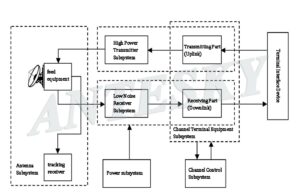
Fig.3 Diagram of earth station system
As can be seen from above Fig.3, the earth station is composed of six subsystems: antenna subsystem, transmitter subsystem, receiver subsystem, communication control subsystem, channel terminal equipment subsystem and power supply subsystem. Antenna system of earth station The reflector antennas are used by earth station antennas, such as parabolic antennas, Cassegrain antennas, improved or modified parabolic antennas and ring focus antenna systems, which main technical requirements are as follows.
- High gain
- Low noise temperature
- Broad band characteristics
- Good rotation
- High mechanical precision
A.antenna subsystem
The antenna system consists of three parts: the main antenna device, the feed device and the tracking device. The feed device is connected between the main antenna device, the transmitter and the receiver, and its function is to feed the RF signal output by the transmitter to the antenna At the same time, the electromagnetic wave received by the antenna is fed to the receiver, that is, it plays the role of transmitting energy and separating the sending and receiving waves. The typical feeding equipment consists of a feed horn, a wave guide element (directional coupler, polarization conversion and duplexer), That is to say the loss of the feeding equipment must be small enough.
Antesky Science Technology Inc. was built in 1985, we’re mainly engaged in the design and manufacture of satellite communication large satellite dish,VSAT antenna,TVRO antenna, Portable flyaway antenna and relevant control and tracking system. We have a selected range of antenna in the frequency band, such as C-band, Ku-band, X-band, L-band, S-band, Ka-band, DBS-band. Antesky is insisting in producing high quality antenna with good price.
B. Receiver subsystem
Because the transmitting power of the satellite transponder is small, only a few watts to several tens of watts, and the gain of the antenna is not high, after the downlink loss of about 200dB, the signal reaching the earth station is extremely weak.
The low noise amplifiers used in the microwave frequency band are mainly low noise transistor amplifiers, field effect transistor amplifiers and parametric amplifiers.
The microwave signal amplified by the low-noise amplifier in the down-converter is sent to the down-converter to be converted into an intermediate frequency, and then sent to the demodulator after being amplified by the intermediate frequency.
C. Transmitter subsystem composition
Fig.4 Diagram of transmitter subsystem composition
D. Channel terminal sub-system
The channel terminal equipment subsystem can be divided into two parts of uplink and downlink.
The uplink part is the terminal equipment of the originating channel, which performs baseband processing on the multi-channel telephone, TV and service signals, modulates the 70MHz carrier with the synthesized baseband signal, and becomes an FM signal, which is then sent to the transmitter system for frequency conversion.
Downlink part of the channel terminal equipment is the task of the downlink part , which is to output the baseband signal after the 70MHz signal sent from the low-noise receiver, after mid-amplification, demodulation and baseband processing, and then send it to the terminal interface equipment to decompose the baseband signal .
E. Controller sub-system
The earth station is quite complex and huge. In order to ensure the normal operation of each part, it must be monitored, controlled and tested centrally in the station.
F. Power supply sub-system
The power supply subsystem of the earth station needs to supply the electric energy required by all the equipment in the station, which is related to the quality of communication and the reliability of the equipment.
3. Characteristics of satellite communication system
3.1 Downlink broadcast, wide coverage
It is not sensitive to ground conditions such as mountains and oceans, and is suitable for providing large-scale coverage in areas with sparse traffic. Communication can be performed at any point in the coverage area, and the cost is independent of distance;
3.2 Working frequency bandwidth
Available frequency bands are from 150MHz to 30GHz. At present, the development of 0 and V bands (40~50GHz) has begun. The Ka band can even support data services of 155Mbps;
3.3 Good communication quality
In satellite communication, electromagnetic waves mainly propagate outside the atmosphere, and the propagation of radio waves is very stable. Although propagation in the atmosphere is affected by weather, it is still a highly reliable communication system;
3.4 Fast network construction and low cost
In addition to building ground stations, no ground construction is required, which is with low operation and maintenance costs;
3.5 Large signal transmission delay
The two-way transmission delay of high-orbit satellites reaches the second level, and there will be very obvious interruptions when used for voice services;
3.6 Complicated control system
Since all the links in the satellite communication system are wireless links, and the position of the satellite may be constantly changing, the control system is also more complicated.
That’s all introduction about satellite communication system, if you have any other question, welcome to contact with us via sales@antesky.com Thanks!

